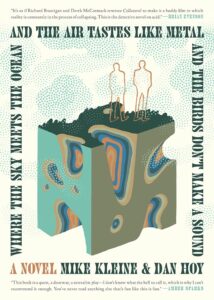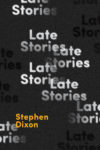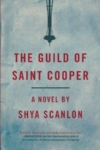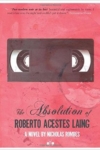
[Trnsfr Books; 2021]
The premise of the novel Where the Sky Meets the Ocean and the Air Tastes Like Metal and the Birds Don’t Make a Sound, co-authored by Mike Kleine and Dan Hoy is spelled out in the epigraph:
Detectives Michael and Daniel try to
solve a murder on planet Earth.
The setting is laid out then as planetary, and also opens up the possibility of the extra-planetary. In orienting towards the earth, the reader is simultaneously disoriented by a lack of national or regional specificity, as well as the implication that earth is simply one in a series of planetary coordinates that only happens in this work to be the one narratively and, idk, executively investigated.
The title itself similarly tracks down a point in space that is as precise as it is unlocatable, insofar as finding it hinges on the objective senses of the subjective individual. The long title’s verbs index four out of five of the human senses: taste and sound directly, and then obliquely sight and touch through “meet.” Scent is verbally absent, but taste and smell are so synesthetically linked that the reader can almost smell the sense through “ocean” and “metal,” respectively salt, and then some “where” between rust and blood.
Proust in In Search of Lost Time famously associated the taste and olfactory organs with the memory organ, specifically in the scene where the narrator dips that time-trapping madeleine in tea, and it recovers for the narrator a world he’d thought lost: “But when from a long-distant past nothing subsists, after the people are dead, after the things are broken and scattered, still, alone, more fragile, but with more vitality, more unsubstantial, more persistent, more faithful, the smell and taste of things remain poised a long time, like souls, ready to remind us, waiting and hoping for their moment, amid the ruins of all the rest; and bear unfaltering, in the tiny and almost impalpable drop of their essence, the vast structure of recollection.” Proust is beautiful because the world is not lost. Ruins are beautiful in the same way. Ruins are more beautiful than monuments, and Proust writes about the relationship between the two, how ruins are just monuments with the symbolism dripping away. We still experience within our “vast structure of recollection” a feeling of loss, because there is no actual material re-collection of what no longer persists, but at least memorial oblivion is impossible. Ruins can be excruciatingly enjoyed so long as the world persists and offers its shards to be shored up by the feeling, sensing, subjective individuals we are who need an objective, or at least persistent world.
In Hoy and Kleine’s novel, planet Earth’s persistence is no longer a given, and an entire world — our world — is in fact on the brink of loss and ruination. The first scene opens on ruination:
THEY’RE JUST standing there, staring at the body.
It’s not clear how long she’s been dead but long enough
that it’s clear she’s dead.
Michael says, I hate that she’s dead.
Daniel says, I know.
As in the show Twin Peaks, co-authors Mark Frost and David Lynch establish an opening scene in which the lifeless body of high school girl Laura Palmer is found, and protagonist-detective Dale Cooper investigates her grisly murder. I will point out later some of the many explicit references to David Lynch and Twin Peaks the novel makes. For now, I think it’s useful to focus on the first scene of Twin Peaks which,for some reason, isn’t detailed at all in Wikipedia’s Episode 1 plot outline, but which I think is foundational to the entire show, maybe even to the entirety of Lynch’s oeuvre, in terms of how Lynch uncannily disorients, and literally displaces, the viewer and everything the viewer thinks the viewer understands about viewing.
The episode begins with Laura Palmer’s plastic-wrapped body washing up on shore and there is only one unwitting witness, the avid fisherman Pete. Pete calls Sheriff Harry Truman’s office and is put on hold by secretary Lucy, who then tells Harry:
“It’s Pete Martell up at the Mill. I’m gonna transfer it to the phone on the table by the red chair . . . the red chair against the wall. The little table with the lamp on it. The lamp that we moved from the corner. The black phone. Not the brown phone.”
This whole time Harry’s giving her a bemused look, glare-adjacent, but upon answering soon shows himself similarly preoccupied with questions of place and position:
Harry: “Mornin Pete, [it’s] Harry”
Pete: “She’s dead. [he breathes and heaves] Wrapped in plastic. [more breathing and heaving]”
Harry: “Wow wow wow hold on, hold on a second Pete . . . Where?”
Who is outside the orbit of Detective Truman’s concern. Where the Sky Meets the Ocean and the Air Tastes Like Metal and the Birds Don’t Make a Sound: A Novel, like Twin Peaks and like True Detective and like Roberto Bolaño’s Savage Detectives and like Tom Stoppard’s Rosencrantz and Guildenstern Are Dead and like the function of detectives in general and like the function of cops in general and like the function of the novel in genre, doesn’t necessarily care who or what is alive or dead or even why, but rather where. It tracks bodies, and tracking bodies is in the end a matter of time. I think this is the plot of Hoy and Kleine’s book, but agonized: tracking bodies of water that are still navigable, and plots of land that are still habitable, becomes its own detective chase in the era of the Anthropocene:
THE MAN of One Thousand Years says, if you place an ant on
a piece of bread and tell the ant it can never leave that piece of bread, how long
until the ant runs out of bread.
The writing of Where the Sky Meets is characterized by curious combinations of styles such as lyrical and deadpan, spare and tautological (in the best of ways), impressionistic and precise and, narratologically speaking, episodic as well as autotetelic:
AN HOUR goes by.
An entire day.
Michael feels life segmented by a dotted white line.
The sun drops below the horizon and Daniel makes a
hard right.
This passage takes up the space of an entire page. Similarly, “passage” of time is more metaphorical than linear, whereby 1 hour is suddenly replaced by 24. We don’t know what the main character Michael feels exactly — his “own” life? biological phenomena? experiential phenomenology? — but we know it has been made graphical, representative via figuration or perhaps writing. The celestial body of the sun moves in space on the same scale and plane as the earthly body of Daniel’s [car] turning. The novel signals itself, here especially, as a work of prose poetry: prose operating on the level of dotted white linearity, and poetry on the level of the collapsing and expanding metaphor, of time’s accretion and time’s replacement. And yet, the novel titularly self-identifies as novel. How it does so diegetically is a different matter:
MICHAEL DROPS the keys and a voice in the darkness says,
can you see it.
Someone is singing The Rolling Stone backstage photo
session version of “Wild Heart” by Stevie Nicks.
Daniel turns and DJ Face is pointing at the sky.
The tip of his finger is the end of all things.
Daniel looks at Michael and Michael looks up and sees a
black hole coughing up light like blood.
At this point, it’s esoteric cosmology, soft science fiction
and low-fantasy-everything.
Our heroes Michael and Daniel are in a karaoke bar watching “TERROROKE.” The synesthesia of the scene is remarkable. The voice comments on the sight in the darkness of the sound of the photo session version of a Stevie Nicks song, the title of which is nearly identical to David Lynch’s film “Wild at Heart.” Willem Dafoe’s head explodes, so it’s a good film. Daniel turns but we don’t know whether he actually sees DJ Face — a synesthetic name that seems a club pseudonym for god — pointing his apocalyptic finger’s tip at the sky or ceiling or vault of heaven. Heaven is replaced by a black hole “coughing up light” — is light here spasmodically visible, or auditory? — like blood. And after all this Revelations-esque, eschatological eclipse-speak, we have what appears to be an ars poetica of the novel: soft sci-fi, low-fi everything, a prose poetry novel investigating the now, the new and novel, and the end:
The Man of One Thousand Years says, it’s the end of the
end of the world and nobody cares. Of course, nobody has ever
had any reason to care about the end of the world because the
world has been ending since the beginning of the world. But
to not care about the end itself ending. The end itself.
In Amitav Ghosh’s The Great Derangement: Climate Change and the Unthinkable, Ghosh diagnoses in modern literature, and particularly in the genre of the novel, a problem of imagination that is in fact a problem of seeing, a cultural literal worldview. Focusing specifically on climate change as both a problem of the Now and of the Future, he bemoans the fact that novels deal only with the probable and, because the drastic effects of climate change are still so unthinkable in this present moment — so politically fraught because we cannot imagine a way out of the system of capitalism, one of whose symptoms is industry and, by extension, climate change — novels relegate such concerns to, let’s say, lo-fi genres:
Indeed, it could even be said that fiction that deals with climate change is almost by definition not of the kind that is taken seriously by serious literary journals: the mere mention of the subject is often enough to relegate a novel or a short story to the genre of science fiction. It is as though in the literary imagination climate change were somehow akin to extraterrestrials or interplanetary travel.
I don’t think climate change is among the primary concerns of Hoy and Kleine’s novel. Thankfully, however, early on in the novel the reader gets a delightfully overwhelming hint of the concerns for the authors — and of the investigation for the characters — in the form of what feels like one of Bernadette Mayer’s list poems:
Daniel and Mahmoud discuss the Bay of Pigs, the Reagan presidency, Tim Hecker and his music, death holes, black magicks, underwater societies, nuclear energy, semantics, home invasions, white guilt, faux pas, closets, public feelings, dirty laundry, skeletons in the closet, tfw . . . hate crimes, reparations, the nudging state, truth and reconciliation commissions . . . the judicial system, teachers, shunning, rape culture, bravery, memorials, survivor’s guilt, victim blaming, earth magnets, psychoanalysis . . . kayaktivism, yachts, irrigation, liquefaction, lawns, droughts, desalination, filtration, electric potential, wastewater, swells, crystals, purification, climate redlining . . . Freuds oceanic feeling, baptizms, hikikomori . . . the Black Atlantic, diasporas, the ozone, sublimations . . . psychoanalysis, David Lynch films, gender politics, medieval literature, porn culture . . . Iranian philosophy, leaderless resistance, modern Islamic philosophy, gender fluidity, Guyotat, firefighters, gay for pay, streamers . . . the Tasmanian Devil, DB Cooper, earth magnets, the Arkestra, ball lightning, 433 Eros, USA for Africa . . .
“kayaktivism” made me laugh out loud. This isn’t even 1/4th of the list, and the ellipses are my own. I’m interested in how seemingly associative it is, the automaticity of the decision chain that writes, well, this decision chain, each link. Again, though, notice “David Lynch films” and “DB Cooper,” the latter being detective Dale Cooper of Twin Peaks. Is this a dizzying statement of the themes of the novel? If so, it feels relevant to point out the repetition of “psychoanalysis” (pairing well with “Freud’s oceanic feeling”) and how, in keeping, smack in the center of the book is mention of a blank billboard, and then a beautiful drawing of one (which I do not include, just look at the white space of the page/screen):
THEY PASS the Golden Essex country club and Fields of Fog.
There’s kids outside with their moms and no dads.
Daniel says, after all of the old continents are gone, someday, it’ll be nice to finally return to Algiers.
Michael nods.
They pass a blank billboard.
Is the blank billboard the wiping clean of a world-sized slate, i.e. an apocalyptic event? The world does appear to end at the end of the book, but this is its center — everything else has been and hereafter will be only fields of fog — a blank space for advertising. The etymology of “advertising” is to “warn”: what does the book warn us of? Why does the book appear to start over, over here?
Again, Ghosh: “In a substantially altered world, when sea-level rise has swallowed the Sundarbans and made cities like Kolkata, New York, and Bangkok uninhabitable, when readers and museumgoers turn to the art and literature of our time, will they not look, first and most urgently, for traces and portents of the altered world of their inheritance? And when they fail to find them, what should they — what can they — do other than to conclude that ours was a time when most forms of art and literature were drawn into the modes of concealment that prevented people from recognizing the realities of their plight? Quite possibly, then, this era, which so congratulates itself on its self-awareness, will come to be known as the time of the Great Derangement.”
Let’s start over, over here. The book begins by marking an interest, perhaps a fixation, with David Lynch and his generic legacy, while simultaneously perhaps marking a point of departure. There are many points in this book:
-The geographic coordinates, or points, of the authors are listed at the end of the book.
-The soon-to-be murdered earth is the point of action, the whole setting, for the novel.
-The point of the story is to investigate the murder of a woman.
-The point of the novel as a genre is a tracking device, something that looks at the world.
The last two points interest me the most. Gender and Genre being etymologically the same word, in what way does the genre of the (detective) novel re-capitulate the logic of the female body as the inert inauguration site of the male author’s opportunity for sighting? Is this itself part of the investigation of this particular novel? I see evidence that it is; Where the Sky Meets takes on the task of challenging the gender violence of a highly gendered genre — “I hate that” — but I still see more room for opportunity to thematically and narratively contest it. The introductory “I hate that” at least seems a wholesale rejection of the gender expectations of the genre — as if the characters are themselves watching the pilot of Twin Peaks or True Detective — but the fact that the murder case seems dropped by the plot’s end seems to only recapitulate the detective-genre logic of gender violence being a springboard to further action for the male detective, unfortunately seeming to mark the gesture of refusal as somewhat perfunctory. On the other hand one could make the argument that the characters are punished for abandoning the case with the banishment of the world. It’s murky; I don’t know. The formal properties of this novel however — the generic distortions — more clearly and concretely open a zone for play and contestation by presenting the world as we currently see it as vulnerable, in need of saving, and rhetorically constructed, thereby allowing it to be newly configured and newly seen or, as Gosh stated, that works against the “modes of concealment that prevented people from recognizing the realities of their plight.”
THERE IS an invisible wind.
But wind already is invisible. The experience of displacement rejuvenates the act of looking, where the familiar is made foreign, like in translation. Sometimes all of the action centers around looking:
The centaur man looks at Michael.
Daniel says to the centaur man, so you are saying that
Shalimar is what we should be looking for,
The centaur man looks at Daniel and Michael.
Daniel looks at Michael.
Michael says, this is ridiculous.
What happens next is sort of difficult to explain.
There is a broken sound.
And the centaur man sort of half-implodes and half-bends
into a smashed shape that should never be.
Daniel looks away.
We know what broken looks like if we know what whole looks like. We know there are breaks in songs, as well as The Break in beats. Centaur here is broken in action, but beforehand is broken down by gratuitousness: we know already a centaur is a half-man, but in seeing it it looks strange, this concept we have of a half or a full man.
After a little bit, the prayers (of both Daniel and Michael, combined) create a result.
The obelisk reveals a portal, shooting straight to Munt-Q’kwah Cliffs.
When they look thru, to the other side, they see a man who is a man.
I’ve never heard of prayers that create a result, outside of the realm of miracles. I’ve never seen a miracle, and I’ve never formed nor been responsible for a miracle. Writing sometimes feels miraculous, and Dan and Mike together created a result that I am reading. I used to pray a lot and believe in something and then I read about the Crusades and decided it was all an ugly violent sham, and stopped praying and started writing. And then I got down to looking, and seeing a man who is a man can be astounding and disorienting, too. And so retroactively — after the half man half centaur moment — “a man who is a man” takes on meaning, where the things we knew that we know are called into question and estranged.
This is the hallmark and perhaps the promise of the Lynchean, something Hoy and Kleine do very well; it’s not the strange that are the strangest things in their work, but the heretofore familiar things that suddenly are seen again in a new and estranging light, that become uncanny. Things don’t look “like” anymore, but unlike. The visual organ, what we depend upon so often for recognition, is re-cognized. If the objective world is re-revealed to be accessed only subjectively, then we are afforded the opportunity of rediscovering it, of finding and recovering what we had thought lost and of discarding the systems that threaten to obliterate it. I see here, then, an entryway into imagining how to write about the impossible-seeming facts of this current non-eventual world. This entryway is through place. Place is a touchy subject, a landscape as tangible as it is abstracted and rhetorical. How is this world configured, written, crafted, and in what ways can it be undone to be seen again — to be re-cognized, rewritten, reconfigured through figuration — and thereby saved?
“The sky is an essential watercolour sort of blue.”
I should mention at the end — the Who and not the Where this time — that characters largely come and go and have strange names. The Man of One Thousand Years is the villain of the book, a man whose identity is marked by temporality, and yet he seems to be talking of “the end” spatially, the end of the world-sized piece of bread, or a sidewalk imagined by a sort of evil Shel Silverstein. There is “Jane from Yesterday.” There is of course DJ Face and there are vampires and centaurs and butlers and mages oh my. And then there are Michael and Daniel.
Michael and Daniel are strange names in a way, too. Michael and Daniel are presumably avatars of Mike Kleine and Dan Hoy. Because the characters’ names are longer, do they seem realer than the authors? Roberto Bolaño’s fictional conceit, especially in the novel The Savage Detectives, posed a so-called Arturo Belano as the character that authored all the works in which he was a character. You can call it metaphysical displacement or a postmodern technique or whatever you want, really, but the end result is as clear as it is vague, wherein a shroud of the fictive protects the facticity of the biographical personage, the author, who in our culture is already shrouded in an air of mystery and mythology and world-building. Miguel de Cervantes was a character in the Quixote, too, and he arguably prototyped what would soon be considered the Modern NovelÔ. It was all about disaster, the disaster of the monocultural nation, the Inquisition qua investigation, the expulsion and the burning of the Jews and the Muslims and women and other such heretics, the end of a world. I exceedingly liked the book, read it cover to cover in a sitting. I wonder whether the investigation is over, or if it’s even begun. The murder case appears dropped by the end. The whole world.
Jared Joseph is boring.
This post may contain affiliate links.







